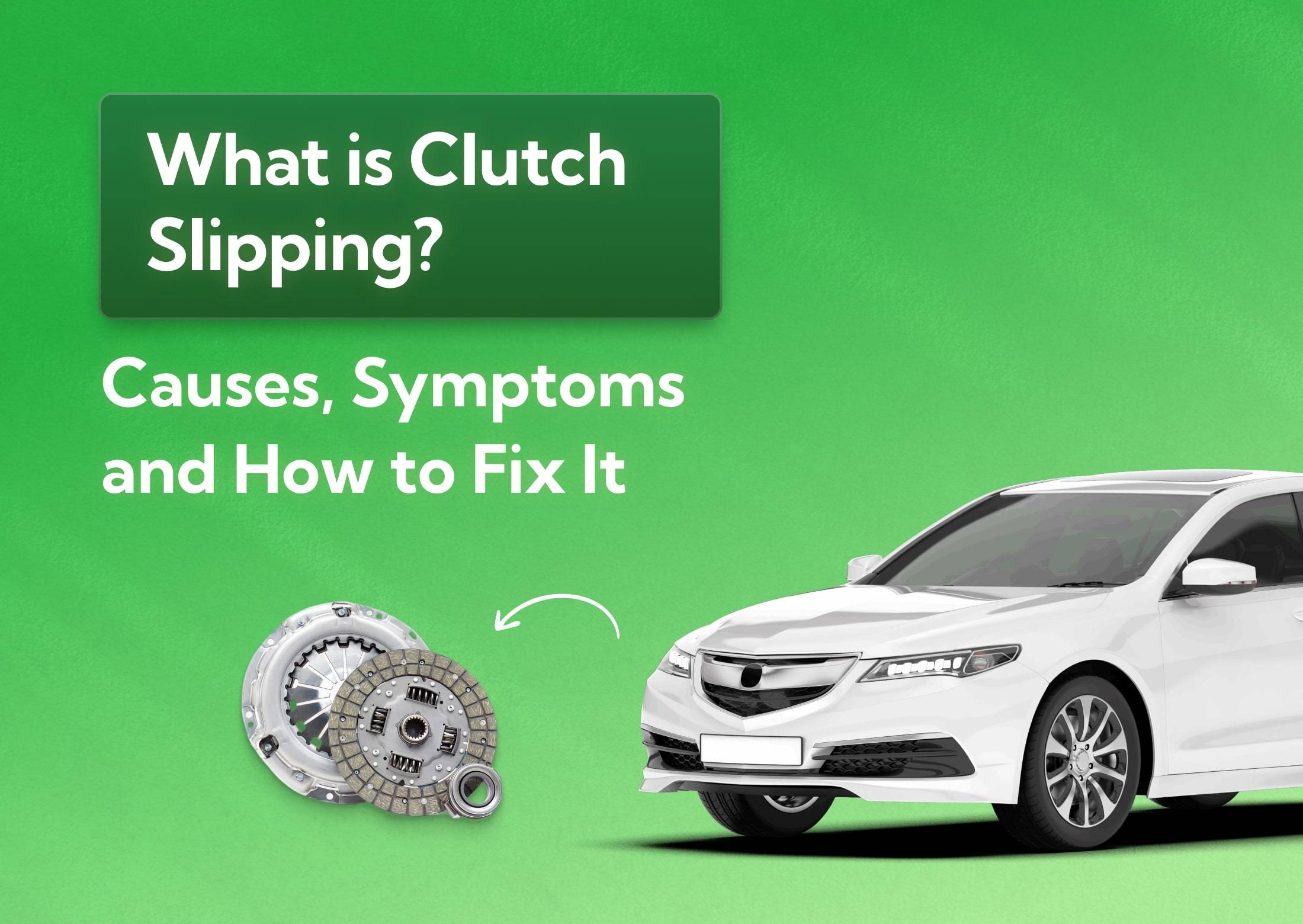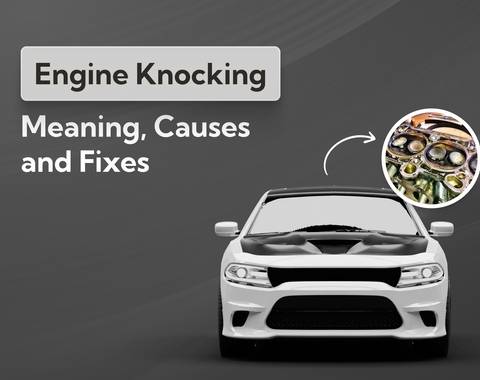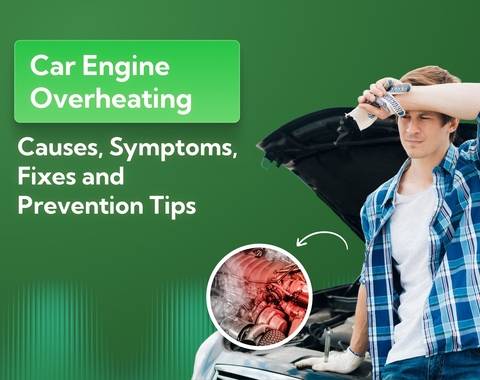What is Clutch Slipping? Causes, Symptoms and How to Fix It
If your engine revs climb but the car barely moves, your clutch could be slipping. In this guide, we’ll break down what causes it, how to tell if it’s serious and what it’ll cost to repair or replace. That way, you know when to fix it and whether to scrap it.
Last updated: 31st October, 2025

Anthony Sharkey is COO at New Reg Limited (Car.co.uk, Trader.co.uk, Garage.co.uk), driving innovation in vehicle recycling, logistics, and customer experience.

Listen to this story
If you’ve ever pressed the accelerator and felt the revs shoot up but your car barely moves faster, that’s clutch slip. It’s one of those problems that creeps up slowly. You ignore it once, twice, then suddenly you’re stuck halfway up a hill wondering why your car feels like it’s lost its bite.
A slipping clutch means the clutch plate isn’t gripping the flywheel properly. Instead of locking the engine power to the wheels, it’s partially slipping, wasting energy as heat. That’s why you’ll notice rising revs, a burning smell and that weird feeling like the car’s power is fading.
Here’s the thing: clutch slip is either not that serious or very serious. If something small is causing it (low clutch fluid, air in the line or a cable that’s too tight), you can sometimes fix it by bleeding the hydraulic system or adjusting the pedal free play. But if the clutch itself is worn out, you’re looking at a total system replacement. No middle ground.
In today’s article, we’ll talk about what causes it, how to spot it early and what you can actually do to fix it before it burns a hole in your wallet.
What's in this article
- 1. What are the main causes of clutch slipping?
- 2. What are the symptoms of a slipping clutch?
- 2.1 RPM increase without acceleration
- 2.2 Burning smell
- 2.3 Sluggish acceleration
- 2.4 Difficulty shifting gears
- 2.5 Engine revving
- 2.6 How much does it cost to fix a slipping clutch?
- 2.7 Cost to replace a clutch
- 2.8 Cost to repair a slipping clutch
- 2.9 Factors influencing clutch repair and replacement costs
What are the main causes of clutch slipping?
The main causes of clutch slipping are tied to wear, contamination and poor adjustment. In simple terms, the clutch isn’t gripping the way it should either because the parts are worn, coated in oil or just not set up right.
Let’s take a closer look at what typically causes it:
Worn clutch disc
This is the big one. The clutch disc is made of friction material, a bit like brake pads, and over time, it just wears down. When it gets too thin, it can’t grip the flywheel firmly, so it slips under load. You’ll notice it most when accelerating hard, towing or driving uphill.
Oil contamination
If oil leaks from the rear main seal or gearbox input shaft, it can coat the clutch disc in fluid. Once that happens, the friction surface turns slick and the clutch can’t grab. You might also smell something burnt, which would be the oil cooking on hot metal.
Weak or misadjusted clutch springs
The clutch pressure plate uses springs to press the disc against the flywheel. If those springs are worn, broken or not applying enough force, the clutch will slip even if the disc itself is fine. It’s common in older cars and those with high mileage.
You can check if this is the issue by paying attention to how the clutch pedal feels. If it feels unusually soft, spongy or has very little resistance, the pressure plate springs might be weak or not engaging properly.
Another giveaway is when the clutch bites very high on the pedal. That means the springs aren’t clamping down with enough force.
Glazed flywheel or pressure plate
This happens when the clutch has already been slipping for a while and heat builds up between the disc, flywheel, and pressure plate. That heat smooths and hardens the metal surfaces, glazing them like glass. This makes it unable to grip, so even a new clutch will slip unless those surfaces are resurfaced or replaced.
The easiest ways to spot it are by the clutch slipping even after fitting a new disc or by seeing a shiny, bluish tint on the flywheel or pressure plate when they’re removed. It’s a dead giveaway that the surfaces need resurfacing or replacement before refitting the clutch.
Misadjusted clutch cable
If your car uses a manual clutch cable instead of a hydraulic system, there’s a chance it’s just adjusted too tight. That constant tension prevents the clutch from fully engaging. Luckily, this is one of the cheaper, quicker fixes. A simple adjustment or cable replacement can sort it.
Here’s how:
- Find the adjustment point. It’s usually where the clutch cable meets the clutch fork or pedal assembly.
- Loosen the locknut. Use a spanner to free the locking nut that holds the adjustment nut in place.
- Turn the adjustment nut. Turn it clockwise to tighten (less pedal free play, clutch engages sooner). Turn it anti-clockwise to loosen (more free play, clutch engages later).
- Test the pedal. You want around 10-20mm of free play at the top of the pedal, enough so that the clutch fully engages when released.
- Lock it back up. Tighten the locknut and take the car for a short test drive.
What are the symptoms of a slipping clutch?
Like most issues you can have with your car, it’ll tell you when something’s wrong here. But you’ll have to know what you’re looking for if you want to properly diagnose it. If the clutch is slipping, you’ll feel the car losing its usual pull, smell something off and notice your revs behaving strangely compared to your speed.
Here’s how to recognise it before it leaves you stranded:
RPM increase without acceleration
This is the classic giveaway. You press the accelerator, the revs jump, but the car doesn’t move any faster. That means the engine spins freely but the gearbox doesn’t get the same power transfer. It’s especially noticeable in higher gears or when overtaking someone on the highway.
But, to be fair, other causes can mimic that same symptom. One example is wheelspin on wet or icy roads, where revs shoot up but you’re not moving faster because the tyres have lost traction, not the clutch.
So, the test is all about consistency: if the revs flare up every time you accelerate hard (especially in higher gears or on a hill) and there’s no loss of traction, it’s almost certainly the clutch slipping.
Burning smell
A strong, acrid burning smell like hot brakes or melting plastic usually means the clutch is overheating. That’s the friction material cooking as it slips against the flywheel. If you smell it after a hill start or heavy acceleration, it’s time to get it checked.
Sluggish acceleration
Even when you floor it, the car feels lazy and slow to respond. It’s because the clutch is wasting engine power as heat instead of converting it into motion. A slipping clutch makes even a healthy engine feel weak.
Most of the time, sluggish acceleration means the friction material has worn down or the pressure plate springs have weakened, both of which require replacement, not adjustment. But there are a few exceptions:
- If the clutch plate, pressure plate or flywheel are glazed, they can’t transfer engine power efficiently.
- In some cases, it can be caused by a hydraulic issue (like air in the clutch line or low fluid), which prevents the clutch from fully engaging.
Those two fixes are less intensive.
Difficulty shifting gears
If gears start to feel stiff and crunchy or you need to push the pedal all the way down to shift cleanly, the clutch isn’t disengaging fully. Its job is to disengage the engine from the transmission to create a smooth gear shift, so this is one of the earlier signs of wear or a hydraulic issue.
Engine revving
The clutch disc is supposed to grip the flywheel tightly when you release the pedal, creating a solid link between the engine and the wheels. But if the clutch is slipping, that grip isn’t solid. So when you press the accelerator, the engine spins faster (revs rise), but the clutch doesn’t transfer that power cleanly to the gearbox.
It’s kind of like revving an engine in neutral: lots of noise, no change in speed. The revs climb because the engine’s working against friction instead of actual load.
What the experts say

William Fletcher MBE
How much does it cost to fix a slipping clutch?
Fixing a slipping clutch costs between £400 and £1,500+. That depends on your car’s make and model, where you live and how severe the problem is. A small hatchback might be at the lower end. A high-performance car in Central London pushes well beyond that range.
Here’s a quick overview of what you might be paying for:
- Clutch fluid top-up or bleed: £80 to £120
- Clutch cable adjustment or replacement: £100 to £250
- Clutch kit replacement (disc, plate, bearing): £400 to £1,000
- Flywheel resurfacing or replacement: £500 to £1,200+
- Full clutch and flywheel replacement: £600 to £1,500+
Let’s dive into the specifics.
Cost to replace a clutch
In the UK, the cost of a full clutch replacement, which means swapping in a new clutch disc, pressure plate (and often replacing or resurfacing the flywheel) while paying for labour, is between £400 and £1,500+ depending on the car, regional cost of living and scope of work.
For economy cars (small hatchbacks / mass-market models) you might expect around £400 to £700 for the clutch kit + labour only, assuming the flywheel is OK. For luxury and performance cars with complex drivetrains you could easily see £800 to £1,500+, especially if flywheel replacement or dual-mass flywheel is involved.
| Make | Average clutch replacement cost by car make (UK) |
|---|---|
| Audi | £819.74 |
| BMW | £603.48 |
| Citroen | £677.43 |
| Ford | £631.93 |
| Mercedes | £877.35 |
| MINI | £727.27 |
| Nissan | £613.50 |
| Peugeot | £673.59 |
| Renault | £899.26 |
| Toyota | £603.73 |
| Vauxhall | £722.24 |
| Volkswagen | £678.70 |
| Volvo | £782.18 |
I generally recommend replacing the flywheel at the same time as the clutch. The labour is already being paid to access the parts. Plus, a new clutch can damage a worn flywheel (and vice versa). It’s almost wasteful to fit a new part onto an old system. You risk slippage (again), early wear and another bill.
According to recent data, replacing a clutch and dual-mass flywheel costs £1,082.95 on average.
Cost to repair a slipping clutch
Here are some typical repair options (rather than full replacement) and their indicative costs in the UK:
- Adjust clutch cable or pedal free-play: £60 to £180
- Top up/bleed clutch hydraulic system (fluid + labour): £80 to £120
- Replace minor components (slave cylinder, master cylinder, clutch fork): £150 to £350 each
- Resurface flywheel (if the surface is glazed) + labour: £200 to £400
When is repair rather than full clutch system replacement the smarter move?
If the issue is clearly adjustment or contamination and the major clutch components (disc, plate, flywheel) are still in good condition, repairing is far more cost-effective. But if wear is obvious, slipping is severe and you’re seeing all the symptoms I went through earlier, full replacement is the only safe long-term option.
Factors influencing clutch repair and replacement costs
The final bill depends on what car you drive, what’s actually wrong, and where you get the work done.
Here’s what really affects the price:
- Vehicle make and model: Older standard cars have an easy-to-access clutch, which keeps labour costs down. On a BMW, Audi or anything with a dual-mass flywheel (i.e. most modern cars with manual transmission), the gearbox layout makes the job twice as long. And you can’t repair a dual-mass flywheel in most cases.
- Transmission type: Manual clutches are usually cheaper to replace. Dual-clutch and semi-automatic systems (like DSG or DCT) involve additional parts and specialist tools. That complexity adds both time and labour cost.
- Labour rates by region: Garages in London and the South East often charge 20-40% more per hour than small-town mechanics. The same job that costs £600 up north could be £900+ in the capital.
- Extent of damage: If you’ve caught the problem early, you might get away with adjustment, a fluid bleed or a resurfaced flywheel. If not, you’re looking at a full kit replacement.
- Parts quality: You can choose between OEM parts and aftermarket ones. OEM parts are better quality but pricier.
- Additional components replaced: Sometimes, mechanics recommend replacing the master cylinder, slave cylinder or release bearing while they’re in there. It adds cost, but it’s smart because it prevents you from paying the same labour a second time.
Should I fix or scrap my car with a slipping clutch?
If you’re staring down a four-figure repair bill, it’s natural to wonder if it’s even worth it. Clutch replacements aren’t cheap and depending on your car’s age, mileage, and condition, the repair might cost more than the car’s value.
When to repair the clutch
If the car’s in good overall shape and the clutch issue is minor (say, air in the hydraulic system, a worn cable or a glazed flywheel that can be resurfaced), repairing makes sense. You’ll spend a few hundred quid, get the car back on the road, and likely extend its life by years.
It’s also worth repairing if it’s a newer model with a solid resale value or if you’ve recently spent money on other maintenance like brakes or tyres. No point scrapping something that’s otherwise reliable.
When to replace the clutch
When the clutch is worn, the damage isn’t minor. You’ll have no choice but to replace it if you want to keep using the car. At that point, it’s a good idea to go through with the repair work when the rest of the car is sound. It’s a one-time cost that restores full performance.
If you plan to keep the car for a few more years, replacing the clutch all at once is also a way to prevent further issues with it down the line. That’s why even if the problem isn’t wear, a lot of mechanics will tell you it’s better to do it all in one go.
Is scrapping your car the better option?
If the repair quote creeps up to 50% of the car’s value, it’s better to scrap your car. For example, if your car’s worth £1,500 and the garage wants £1,000+ for a new clutch and flywheel, it’s not worth it.
Scrapping saves you the ongoing repair cycle and with our nationwide scrap services, you can have the car picked up and get paid as soon as today or tomorrow, completely free of charge.
And remember that if your car’s worth that little, chances are it’s (a) old, (b) high-mileage or (c) both. So you’ll want to factor in other repairs when you apply that ‘50% Rule’ as well. Even if the repair costs £400, do you have other replacements coming up?
How can you prevent clutch slipping?
You can avoid most clutch problems with a bit of care behind the wheel. You don’t have to do anything crazy. Driving smart, keeping things adjusted and not pushing the clutch harder than you need to go a long way.
Here are my four best tips for keeping your clutch functioning properly for as long as possible:
Practice smooth gear shifting.
Don’t rush your gear shifts. Smooth, deliberate gear changes reduce stress on the clutch and gearbox. Let the clutch engage fully before accelerating and don’t dump it suddenly at high revs. That shock wears down the friction material really quickly, particularly in stop-start city traffic.
Avoid riding the clutch.
Resting your foot on the clutch pedal while driving, even lightly, keeps the clutch partially engaged. This causes a tiny bit of unnecessary heat and wear that compounds over time. Get into the habit of moving your foot fully off the pedal when you aren’t shifting. And at traffic lights, pop the car in neutral and take your foot off completely.
Regularly inspect and maintain the clutch system.
Check your clutch fluid level (if it’s hydraulic) and top it up with the correct type if it’s low. Keep an eye out for leaks near the pedal, slave cylinder and gearbox areas.
If it’s a cable-operated clutch, make sure there’s the right amount of pedal free play. And if the pedal feel gets soft, spongy or the clutch biting point is high, have it looked at professionally before it turns into a bigger job.
Avoid excessive towing or carrying heavy loads.
Towing puts tremendous strain on the clutch, even more so when starting on hills. If you regularly haul trailers or heavy loads, your clutch will wear faster no matter what. Use proper towing techniques (low gear, steady throttle, no slipping the clutch) and if you tow often, consider fitting a heavy-duty clutch.
Frequently asked questions
Yes, just in a different way. Automatics use torque converters or wet clutch packs instead of a manual friction disc. When those internal clutches wear or the transmission fluid breaks down, you can get a similar slipping effect with rising revs, delayed engagement or jerky shifts.
Usually not. Clutches are classed as wear-and-tear items, like tyres or brake pads. That means they’re only covered if there’s a clear manufacturing defect, which is rare. Extended warranties sometimes offer limited coverage, but only if the failure wasn’t caused by driver use or neglect.
Double clutching is an old-school technique where you press the clutch twice during gear changes to match engine and gearbox speeds. It reduces strain on the clutch and gearbox in older or high-mileage cars with worn synchronisers. Most modern cars don’t need it, but it’s still useful for smoother downshifts.
Absolutely. A slipping clutch generates excess heat, which warps or glazes the flywheel and pressure plate. Over time, it can even damage the release bearing or slave cylinder. If you don’t check it, you could be looking at a full clutch and flywheel replacement instead of a minor fix.
A well-driven car’s clutch can last 60,000 to 80,000 miles, sometimes more. It all depends on driving style, terrain and how often you’re in stop-start traffic. City driving wears clutches faster because you’re constantly engaging and disengaging it. Smooth motorway drivers usually get much more life out of theirs
About Car.co.uk

Share on
Latest news & blogs










